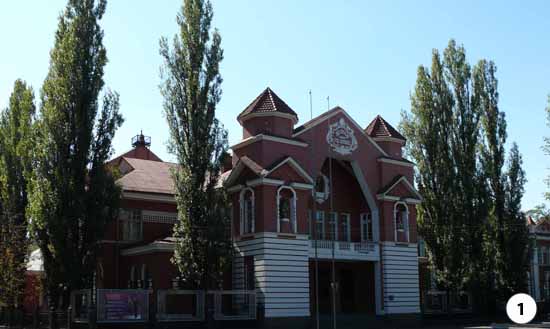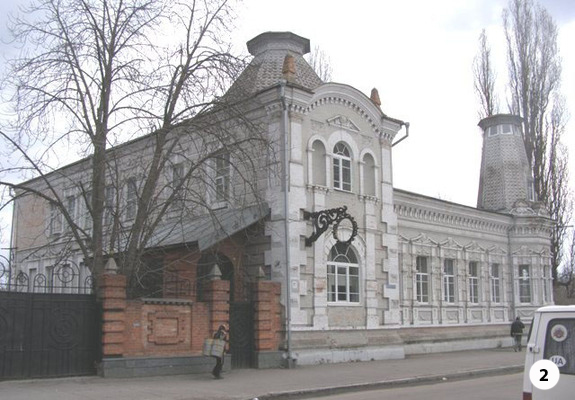Kremenchuk — is hardly a popular tourist destination. Most Ukrainians know little about the city. It is located in Poltava Oblast, North-Eastern Ukraine. It’s an industrial city. And it was mentioned in popular Soviet comedies a few times – probably that is all. Is there something for an interested guest to see? And what is it, because even the internet offers nothing that really stands out. However, for those who are bored of travelling along the common routes, this city may reveal some of its unknown charms.
Driving into Kremenchuk is best done from the right or eastern bank of the Dnipro river. In this way you will be first greeted by one of its most impressive attractions, a very tall bridge over the Dnipro, along with the photogenic landscapes along the river's banks. The bridge has two levels, the lower one is for the railway, while the upper one is for vehicular and pedestrian traffic. The most interesting sensation is to cross it on foot – you move along with the steady flow of cars and hear the rumble of an endless freight train underfoot. The vast water and wind around will turn all this into unforgettable experience.
Like all industrial giants, though, this one is transient. The Kremenchuk bridge today is not only a strategic transportation junction and a site for experience-seekers, but also a pain in the neck for the entire region. Its condition continues to get worse, the bridge is closed over and over again, and the locals say that it would be better to build an entirely new bridge. But the fact that the next nearest crossing is 40 km away only makes things worse.
The Dnipro in Kremenchuk does not look as endless and sea-like as it does in Cherkasy where the river gets the widest. But it does not allow the city to overbear it as in Kyiv. Thus the industrial and natural landscapes are sufficiently harmonious, with quiet islands and channels that look like a boundless lace in distance on the one hand, and the port cranes and railroad junctions – on the other.
READ ALSO: A Village for Fish
Ukraine’s most famous poet, Taras Shevchenko, once wrote down a local folklore song about the Dnipro in Kremenchuk:
A pike swims from Kremenchuk,
Swimming on stealthily,
He that has not fallen in love,
Knows not pain.
A pike swims from Kremenchuk,
It's scales brightly shining,
He that has not fallen in love
Is one without happiness.
The grateful descendants even dedicated a monument to that philosophical fish.
The industrial legacy of Kremenchuk is still relevant. It is one of the few monotowns – Soviet cities whose economy and entire life was dominated by a single industrial plant – where the major plant did not collapse rapidly after the USSR fell apart, and take the city’s life with it. Its industry is hardly thriving today, but the local plants are mostly still in operation. One is KrAZ, a big producer of trucks and special-purpose vehicles. Another one is the Kryukiv Railcar Plant. It has recently produced new metro cars for Kyiv, but failed to win a tender to make new high-speed trains for the Ukrainian Railway for Euro 2012. The government opted for Hyundai as a subcontractor. Subsequently, the Korean trains stopped half-way when the temperature dropped low in winter.

READ ALSO: Euro 2013
The rails, fences, pipes and cranes (much less intrusive than in large industrial cities) are not the only symbols of the industrial Kremenchuk. Some of its districts still have a specific atmosphere, behaviour and appearance of the streets. One is Kryukiv, a small district on the right bank which at one time was not part of the city. It was here that one of the first Ukrainian-Polish peace agreements was signed in 1625 after a lengthy battle. The clothing of its residents – all riding old Soviet-type bicycles – and the view of its establishments fuse into a mutated, self-mocking replica of idealized cheerful characters from the era of advanced socialist.
All this may give you an impression that Kremenchuk has nothing to offer in terms of architecture, but cranes and railway trains. Fortunately, this is not the case, though it does take some effort to find beauty among weird sites like the Independence Square with the hammer-and-sickle crowned column in the middle of it. Hidden behind grey krushchovkas – Soviet apartment blocks with small flats built on a massive scale in the 1950-1960s at Nikita Khrushchev’s order, hence the name – stands a synagogue in the Moorish style. It is on Kvartalna or District Street, one of the city’s oldest streets laid down in 1774. Kremenchuk used to have the largest Jewish community; today, it is mostly Ukrainian. By contrast to the rest of Poltava Oblast that speaks Ukrainian, this city’s language choice resembles that of Eastern Ukraine, so Russian prevails here. On Gogol Street is a building that looks somewhat baroque. It was built in the 18th century to watch over ship traffic on the Dnipro.
Even the industrial Kryukiv district offers some surprisingly nice-looking buildings. One is the house of the merchant and philanthropist Hryhoriy Churkin, built in 1902 (photo 2). On the territory of the abandoned military base near the railway some Classicist buildings have been preserved, however, you will have to see them from afar as you will not be permitted on the territory. You will have plenty of opportunities to examine original early Soviet architecture – such as the Kotlov Palace of Culture (photo 1). Built in 1927, it incorporates details of the late Socialist Realist with elements of Ukrainian Art Nouveau and Baroque, even with hints towards Constructivism.

Kremenchuk has given the world few well-known people, but at least two of them clearly stand out. The first one was a well known educator and writer Anton Makarenko (1888-1939). His experiment in educating juvenile delinquents still sparks debates today. Some see him as a progressive and prominent educator of young criminals, while others claim that all he did was to use prison order in his schools.
The other one is the writer Andriy Holovko (1897-1972), who studied in Kremenchuk. He was an exemplary Ukrainian Socialist Realism writer – somewhat unique, somewhat standard, but never magical. He never became famous for his writing. But he was known for shooting of his daughter and wife in 1923 or 1924, based on different sources. Ostensibly this was due to mental problems caused by his serving in the First World War and the Civil War (today Sovietologists seldom recall that, though experience of long and intensive violence from 1914 to1920 had a strong impact on mental health of people who lived on those territories, including Ukrainians). Eventually, Holovka was never sentenced for this double murder, but sent for treatment. This “inconvenient event” was eventually deleted from the official biography of the writer.
Cultural life in Kremenchuk today seems to not only revolve around local museums, galleries and other permanent art locations, but to try and escape from post-Soviet inertia. The city has an informal intellectual group Prostir idey (A Space of ideas). Its members not only play chess and drink tea, but organize and hold various artistic events. With the assistance of the Committee to Protect the Ukrainian Language, the Mykhailo Ostrohradskyi University offers free courses of Ukrainian for anyone wanting to learn or improve their Ukrainian. It is the success and the scope of such initiatives, among other things, that may change Kremenchuk’s present image of an average industrial city in the future.
A NUMBER OF FACTS FROM KREMENCHUK'S HISTORY
16th century — most researchers believe that the city was founded during this period, though there is uncertainty of specific dates
1550 – mention of the need to reinforce Kremenchuk as an outpost in the fight against the Tartars
1590 – project of building a fortress for the Cossacks, in order to evict them from Zaporizhzhia
1634-1635 – construction of a fortress and castle in accordance to the Universal issued by King Sigismund III. Architectural plan by Guillaume Le Vasseur de Beauplan
1645-1647 – a mini war for Kremenchuk between Stefan Potocki and Yuri Nemyrych
From 1648 — station city for the Chyhyryn and later the Myrhorod regiments
Late 17th century — ongoing fighting
1764 — becomes part and centre of Novorossiysk Province
From the late 18th century – experiences industrial and trade growth
1748-1785 — plague
From 1802 – becomes part of Poltava Province
1869 – the first bridge across the Dnipro river is built
1870 – railway station is opened
1876 – the first theatre is opened
1917-1920 – Civil War. Kremenchuk changes hands many times
LOST SITES
Amongst the many losses of Kremenchuk during the 20th century is the Assumption Cathedral (1804-1816) designed by prominent architect Giacomo Quarenghi (1744-1817). The building in the Empire style was damaged during WWII but survived it to be finally destroyed during the ten-year rule of Khrushchev.
The Kremenchuk tramway is also a memory now. It was launched in 1899 and ceased to exist during the decline that followed the Civil War.

